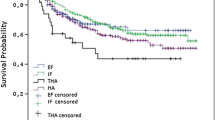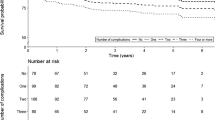Abstract
Hip fracture is an important cause of mortality and disability in elderly patients, particularly in those with poststroke hemiplegia, but little information is available regarding differences of general characteristics between patients with and without hemiplegia who experience hip fractures, factors predicting recovery of prefracture ambulatory status, and mortality of patients with poststroke hemiplegia with hip fractures. We retrospectively reviewed 1379 consecutive prospectively followed patients with hip fractures treated from January 2000 to May 2006. Of the 1379 patients, 101 (7.3%) had poststroke hemiplegia. All patients were followed a minimum of 1 year if they survived more than a year or until death if they died within a year after surgery (mean, 19.5 months; range, 4–49 months). According to the American Society of Anesthesiologists (ASA) rating, the patients with hemiplegia were sicker than patients without hemiplegia, more likely to have three or more comorbidities, lower cognitive ability, weaker prefracture ambulatory status, more days of hospitalization, and higher mortality rate. Gender, ASA rating, number of comorbidities, and prefracture ambulatory status predicted mortality of hip fractures in elderly patients with poststroke hemiplegia, and the ASA rating, number of comorbidities, and cognitive ability predicted recovery of prefracture ambulatory status for these patients.
Level of Evidence: Level II, prognostic study. See Guidelines for Authors for a complete description of levels of evidence.
Similar content being viewed by others
References
Aharonoff GB, Koval KJ, Skovron ML, Zuckerman JD. Hip fractures in the elderly: predictors of one year mortality. J Orthop Trauma. 1997;11:162–165.
Bast BA, Greenwald BD. Preventing hip fracture after stroke. Top Stroke Rehabil. 2007;14:67–79.
Chiu KY, Pun WK, Luk KD, Chow SP. A prospective study on hip fractures in patients with previous cerebrovascular accidents. Injury. 1992;23:297–299.
Clague JE, Craddock E, Andrew G, Horan MA, Pendleton N. Predictors of outcome following hip fracture: admission time predicts length of stay and in-hospital mortality. Injury. 2002;33:1–6.
Cornwall R, Gilbert MS, Koval KJ, Strauss E, Siu AL. Functional outcomes and mortality vary among different types of hip fractures: a function of patient characteristics. Clin Orthop Relat Res. 2004;425:64–71.
Cummings SR, Rubin SM, Black D. The future of hip fractures in the United States: numbers, costs, and potential effects of postmenopausal estrogen. Clin Orthop Relat Res. 1990;252:163–166.
Dennis MS, Lo KM, McDowall M, West T. Fractures after stroke: frequency, types, and associations. Stroke. 2002;33:728–734.
Di Monaco M, Vallero F, Di Monaco R, Mautino F, Cavanna A. Functional recovery and length of stay after hip fracture in patients with neurologic impairment. Am J Phys Med Rehabil. 2003;82:143–148; quiz 149–151, 157.
Elliott J, Beringer T, Kee F, Marsh D, Willis C, Stevenson M. Predicting survival after treatment for fracture of the proximal femur and the effect of delays to surgery. J Clin Epidemiol. 2003;56:788–795.
Endo Y, Aharonoff GB, Zuckerman JD, Egol KA, Koval KJ. Gender differences in patients with hip fracture: a greater risk of morbidity and mortality in men. J Orthop Trauma. 2005;19:29–35.
Fisher M. Stroke and TIA: epidemiology, risk factors, and the need for early intervention. Am J Manag Care. 2008;14(suppl 2):S204-S211.
Forster A, Young J. Incidence and consequences of falls due to stroke: a systematic inquiry. BMJ. 1995;311:83–86.
Gdalevich M, Cohen D, Yosef D, Tauber C. Morbidity and mortality after hip fracture: the impact of operative delay. Arch Orthop Trauma Surg. 2004;124:334–340.
Hamdy RC, Moore SW, Cancellaro VA, Harvill LM. Long-term effects of strokes on bone mass. Am J Phys Med Rehabil. 1995;74:351–356.
Imai Y, Hasegawa K. The revised Hasegawa’s dementia scale (HDS-R): evaluation of its usefulness as a screening test for dementia. Hong Kong Coll Psychiatr. 1994;4:20–24.
Ingemarsson AH, Frändin K, Mellström D, Möller M. Walking ability and activity level after hip fracture in the elderly: a follow-up. J Rehabil Med. 2003;35:76–83.
Ishida Y, Kawai S, Taguchi T. Factors affecting ambulatory status and survival of patients 90 years and older with hip fractures. Clin Orthop Relat Res. 2005;436:208–215.
Jørgensen L, Crabtree NJ, Reeve J, Jacobsen BK. Ambulatory level and asymmetrical weight bearing after stroke affects bone loss in the upper and lower part of the femoral neck differently: bone adaptation after decreased mechanical loading. Bone. 2000;27:701–707.
Jørgensen L, Jacobsen BK, Wilsgaard T, Magnus JH. Walking after stroke: does it matter? Changes in bone mineral density within the first 12 months after stroke: a longitudinal study. Osteoporos Int. 2000;11:381–387.
Kanis J, Oden A, Johnell O. Acute and long-term increase in fracture risk after hospitalization for stroke. Stroke. 2001;32:702–706.
Kelly BM, Pangilinan PH Jr, Rodriguez GM. The stroke rehabilitation paradigm. Phys Med Rehabil Clin N Am. 2007;18:631–650.
Kitamura S, Hasegawa Y, Suzuki S, Sasaki R, Iwata H. Functional outcome after hip fracture in Japan. Clin Orthop Relat Res. 1998;348:29–36.
Koh LK, Saw SM, Lee JJ, Leong KH, Lee J. Hip fracture incidence rates in Singapore 1991–1998. Osteoporos Int. 2001;12:311–318.
Koval KJ, Skovron ML, Aharonoff GB, Zuckerman JD. Predictors of functional recovery after hip fracture in the elderly. Clin Orthop Relat Res. 1998;348:22–28.
Lau EM, Cooper C. The epidemiology of osteoporosis: the oriental perspective in a world context. Clin Orthop Relat Res. 1996;323:65–74.
Lin PC, Chang SY. Functional recovery among elderly people one year after hip fracture surgery. J Nurs Res. 2004;12:72–82.
Lyons AR. Clinical outcomes and treatment of hip fractures. Am J Med. 1997;103:51S-63S; discussion 63S-64S.
Marottoli RA, Berkman LF, Leo-Summers L, Cooney LM Jr. Predictors of mortality and institutionalization after hip fracture: the New Haven EPESE cohort. Established Populations for Epidemiologic Studies of the Elderly. Am J Public Health. 1994;84:1807–1812.
Michel JP, Klopfenstein C, Hoffmeyer P, Stern R, Grab B. Hip fracture surgery: is the pre-operative American Society of Anesthesiologists (ASA) score a predictor of functional outcome? Aging Clin Exp Res. 2002;14:389–394.
Minematsu A. The frequency of family visits influences the behavioral and psychological symptoms of dementia (BPSD) of aged people with dementia in a nursing home. J Phys Ther Sci. 2006;18:123–126.
Morris AH, Zuckerman JD. National Consensus Conference on Improving the Continuum of Care for Patients with Hip Fracture. J Bone Joint Surg Am. 2002;84:670–674.
Myint PK, Poole KE, Warburton EA. Hip fractures after stroke and their prevention. QJM. 2007;100:539–545.
Nevitt MC, Cummings SR. Type of fall and risk of hip and wrist fractures: the study of osteoporotic fractures. J Am Geriatr Soc. 1993;41:1226–1234.
Poole KE, Reeve J, Warburton EA. Falls, fractures, and osteoporosis after stroke: time to think about protection? Stroke. 2002;33:1432–1436.
Ramnemark A, Nilsson M, Borssén B, Gustafson Y. Stroke, a major and increasing risk factor for femoral neck fracture. Stroke. 2000;31:1572–1577.
Ramnemark A, Nyberg L, Borssén B, Olsson T, Gustafson Y. Fractures after stroke. Osteoporos Int. 1998;8:92–95.
Ramnemark A, Nyberg L, Lorentzon R, Englund U, Gustafson Y. Progressive hemiosteoporosis on the paretic side and increased bone mineral density in the nonparetic arm the first year after severe stroke. Osteoporos Int. 1999;9:269–275.
Schrøder HM, Erlandsen M. Age and sex as determinants of mortality after hip fracture: 3,895 patients followed for 2.5–18.5 years. J Orthop Trauma. 1993;7:525–531.
Shah MR, Aharonoff GB, Wolinsky P, Zuckerman JD, Koval KJ. Outcome after hip fracture in individuals ninety years of age and older. J Orthop Trauma. 2001;15:34–39.
Shyu YI, Chen MC, Liang J, Wu CC, Su JY. Predictors of functional recovery for hip fractured elders during 12 months following hospital discharge: a prospective study on a Taiwanese sample. Osteoporos Int. 2004;15:475–482.
The National Working Committee Office on Aging. Report of prediction study on China’s population aging trends. Available at: http://www.cnca.org.cn/default/iroot1000610000/4028e47d16ec2fd901171963a2690382.html. Accessed December 27, 2007.
Tutuarima JA, van der Meulen JH, de Haan RJ, van Straten A, Limburg M. Risk factors for falls of hospitalized stroke patients. Stroke. 1997;28:297–301.
Youm T, Aharonoff G, Zuckerman JD, Koval KJ. Effect of previous cerebrovascular accident on outcome after hip fracture. J Orthop Trauma. 2000;14:329–334.
Zuckerman JD, Skovron ML, Koval KJ. Postoperative complications and mortality associated with operative delay in older patients who have a fracture of the hip. J Bone Joint Surg Am. 1995;77:1551–1556.
Acknowledgments
We thank Sun Fei and Zhu Yan (statistical experts) for invaluable statistical advice; Tan Jing, MD, and Alexi for helpful comments on the manuscripts; Dr Nie Qingbing for collecting documents; and Editor-in-Chief, Dick Brand, and editorial assistant, Ryan Krausmann, for invaluable remarks and instructions.
Author information
Authors and Affiliations
Corresponding author
Additional information
Each author certifies that he or she has no commercial associations (eg, consultancies, stock ownership, equity interest, patent/licensing arrangements, etc) that might pose a conflict of interest in connection with the submitted article.
Each author certifies that his or her institution has approved or waived approval for the human protocol for this investigation and that all investigations were conducted in conformity with ethical principles of research.
About this article
Cite this article
Feng, M., Zhang, J., Shen, H. et al. Predictors of Prognosis for Elderly Patients with Poststroke Hemiplegia Experiencing Hip Fractures. Clin Orthop Relat Res 467, 2970–2978 (2009). https://doi.org/10.1007/s11999-009-0835-5
Received:
Accepted:
Published:
Issue Date:
DOI: https://doi.org/10.1007/s11999-009-0835-5




